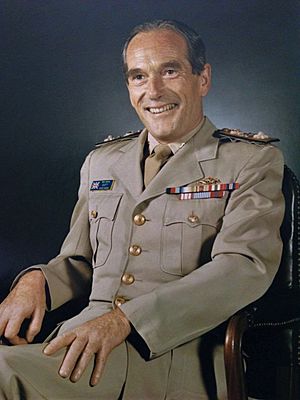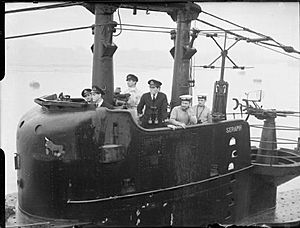David Scott (Royal Navy officer) facts for kids
Quick facts for kids
Rear-Admiral Sir
David Scott
|
|
|---|---|
 |
|
| Birth name | William David Stuart Scott |
| Born | 5 April 1921 |
| Died | 20 January 2006 (aged 84) |
| Buried |
St.Michael's Anglican Church, Camberley
|
| Allegiance | |
| Service/ |
|
| Years of service | 1937 - 1980 (43 years) |
| Rank | Rear-Admiral |
| Awards | Knight Commander of the Order of the British Empire Companion of the Order of the Bath |
Sir David Scott (born April 5, 1921 – died January 20, 2006) was a brave and clever officer in the Royal Navy. He served for a long time, from 1937 to 1980. He was especially known for his important role in a secret mission during World War II called Operation Mincemeat. Scott served on many submarines and commanded five of them. People remembered him as a kind and funny leader.
| Top - 0-9 A B C D E F G H I J K L M N O P Q R S T U V W X Y Z |
Sir David Scott had an amazing career in the Royal Navy. He was involved in many important events. He served during World War II and later helped with Britain's nuclear defense program. His story shows how one person can make a big difference.
Early Days and World War II
When World War II started, Scott was serving on the battleship HMS Revenge. He helped protect ships in convoys and attacked enemy positions. Soon after, he moved to submarines. He served on several older submarines before joining HMS Seraph. Later, he became the commander of submarines like HMS Umbra, Vulpine, and Satyr.
The Secret Mission: Operation Mincemeat
One of Scott's most famous missions was Operation Mincemeat in 1943. He was the first lieutenant on HMS Seraph. This submarine was already known for its secret operations. For example, it helped land General Mark Clark in Algeria and smuggled General Giraud out of France.
Operation Mincemeat was a very unusual plan. It involved tricking the Nazi Headquarters during World War II. Scott's submarine carried a special "package" from Scotland. Scott thought it was optical instruments. But near the Spanish port of Huelva, he learned it was actually a dead body!
The body was dressed as a Royal Marines major. On it were fake secret documents. These documents suggested the Allies planned to invade Southern Europe through Greece. The real plan was to invade Sicily. The idea was to make the Nazis move their troops to the wrong place.
Scott helped launch the body and a life raft close to shore in the dark. The documents were found and reached the Nazis. This trick worked! The Nazis moved their troops away from Sicily, making the real invasion easier for the Allies. This amazing story was even made into a movie called The Man Who Never Was.
After the War: More Adventures
After World War II, Scott continued his exciting career. In 1946, he was on the destroyer HMS Volage. His ship was hit by a mine in the Corfu Channel by the Albanians. Scott showed great courage. His ship then towed another damaged destroyer, HMS Saumarez, to safety. This was a very dangerous rescue.
Scott later commanded HMS Meteorite, an old German U-boat. This submarine used a risky fuel called HTP. It allowed the submarine to go fast underwater without needing air. However, it was very dangerous, and explosions showed it wasn't a good fuel for submarines.
In 1948, Scott was involved in the famous escape of the frigate Amethyst. This ship was trapped by Chinese Communists on the Yangtse river. Scott helped by creating a special code for the Amethyst to communicate safely.
Over the next ten years, Scott worked on developing small submarines. He also commanded a frigate and two more submarines. In 1953, he made the first underwater transatlantic crossing by a diesel submarine in HMS Andrew. This was a long and challenging journey for the crew.
In 1962, Scott studied at the US Naval War College. This started a strong friendship with the US Navy. He then commanded a submarine squadron and a guided missile destroyer, HMS Fife. While on Fife, he sailed all the way around the world!
Leading the Polaris Program
In 1971, Scott was promoted to rear-admiral. He moved to Washington D.C. to lead the British naval mission. There, he built strong relationships with politicians and military leaders. He also became good friends with Admiral Elmo Zumwalt, a famous US Navy chief.
When he returned home in 1973, Scott was put in charge of the UK Polaris programme. This program was about Britain's nuclear missiles carried by submarines. It was a very important job for national defense.
Scott discovered that the costs and timeline for a new part of the program, called Chevaline, were not being properly managed. He bravely reported his concerns to the First Sea Lord. As a result, the department was reorganized. Scott became the chief executive for the Polaris program. He was responsible for both the scientific and naval parts. He worked on the Polaris program for seven years. For his important work, he received high honors, becoming a C.B. in 1974 and a K.B.E in 1977.
Retirement and Legacy
Sir David Scott retired from the Navy in 1980. He then became a director at Civil and Marine, a company that collects materials from the sea. He stayed involved with the company until he passed away.
Scott was well-loved by many people. Some of the men he commanded even named a street after him, David Scott Avenue, in Midlothian, Scotland. Sir David Scott died on January 20, 2006, at the age of 84. He had a wife, Pamela, and three children: Claudia, Richard, and Julia.
Images for kids




